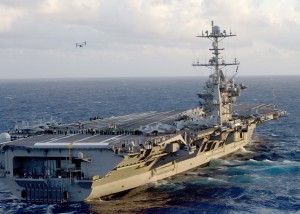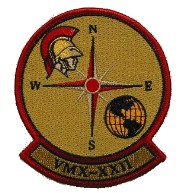2012-12-09 The Marines have stood up their first squadron of F-35 Bs at MCAS Yuma.
But the Marine Corps approach to the aircraft is built on recognition that in addition to its role as a strike aircraft, it has C2 and Information Warfare capabilities, which will make it a central piece to the ACE or Aviation Combat Element of the MAGTF.
To shape the approach, to determine the evolution of the aircraft is firmly rooted in a triangular approach taking shape at Yuma.
Two squadrons will be established and are the operators. MAWTS-1 will develop tactics and training for the F-35 B in conjunction with the other aviation elements for the ACE. And VMX-22 will focus on the technologies and systems of the platforms making up the evolving ACE for the MAGTF.
As Michael Orr, the CO of the squadron underscored, “we are testing all USMC platforms working together in developing Marine aviation capabilities. We are not just testing individual platforms. This is especially crucial when you have dynamic, transformational platforms such as the Osprey and the F-35.”
http://www.aviation.marines.mil/Leaders/tabid/490/Article/129309/colonel-michael-r-orr.aspx
In this interview, Orr describes the basic role of the squadron and its evolution as it transitions to Yuma. In a second interview, Orr discusses his thinking about how these platforms will cross link to shape the evolving ACE of the future.
SLD: Could you explain the role of the squadron?
Orr: I’m privileged to lead Marine Operational Test and Evaluation Squadron 22. We conduct operational testing on assigned USMC aircraft under the authority of the Commander, Operational Test and Evaluation Force and the direction of the Deputy Commandant, Aviation.
We used to be called Marine Tilt-Rotor Operational Test and Evaluation Squadron 22, and the name of the squadron and the number of the squadron should give away a little bit about its lineage. The squadron was created during the development of the V-22 Osprey program because of the services’ emphasis on the successful operational evaluation of the V-22.
SLD: So the squadron was a crucial element of getting the V-22 out to Iraq and then on to Afghanistan?
Orr: Absolutely. In order to reach full rate production and get the aircraft to the deploying squadrons, the V-22 needed to pass its operational evaluation.
The Marine Corps’ leadership at the time was not satisfied with the test structure that was in place and wanted to formally establish its own operational test and evaluation squadron.
This was a big step for the Marine Corps.
Major General Walters, at the time Colonel “Bluto” Walters, was the first CO. His task was to get the V-22 through its formal operational evaluation period and get it out to the hands of war fighter.
The squadron was remarkably successful in that role, built and trained the first cadre of operators and essentially laid the ground work for the V-22 to go on and be a very successful fleet aircraft.
SLD: Prior to this the Marines tested through a Navy structure?

Orr: For the most part we did. Operational testing was conducted by HMX-1 for assault support aircraft, VX-9 in China Lake for our fixed wing and H-1 aircraft, and VX-1 at Patuxent River for C-130s.
After the launch of the Osprey, the squadron’s focus was on testing upgrades on the V-22 and on some new mission systems.
A lot of that changed under Lieutenant General Trautman, then Deputy Commandant of Aviation, when he made a decision a few years ago to expand the scope of the squadron to include not just the V-22 and the CH-53, but also the F-35B and future Marine Aviation platforms.
https://sldinfo.com/the-usmc-in-transition-the-impact-of-yuma/
I’m pretty sure that’s why a fixed wing guy like me was chosen to head this new organization. I’m an F/A-18 driver by trade and I had trouble spelling the word “test.”
I’m still learning a lot about the test mission, and I have tremendous respect for the professionals who know this business inside and out. My primary focus is to lead this squadron in its transformation from a tilt-rotor and rotorcraft squadron to an ACE or Aviation Combat Element-focused test and evaluation squadron for the MAGTF.
SLD: In effect what you’re doing is you’re taking the new aviation assets and you’re figuring out how those aviation assets individually need to operate, operate as a fleet and then cross-link and obviously with a distinct eye to MAGTF operations because you’re all MAGTF officers.
Orr: Developing this interoperability of aircraft and systems is where we will see revolutionary improvements in the capabilities of Marine aircraft. It is an exciting time to be involved in Marine Aviation as all these new platforms come online in the next few years.
How do we get the aircraft to work together? Who currently focuses on all the systems that are going to be required to achieve true interoperability?
Right now the squadron is located out of New River, North Carolina, which made sense when you were a tilt-rotor and rotorcraft-based test squadron, but we will be moving to Yuma in the next few years, which will be critical re-focusing our efforts on the entire MAGTF.
When we’re in Yuma we’re going to be set up right across the street from MAWTS 1, and we’re very excited about this because this will give us the opportunity to have systems development work side-by-side with tactics development.
And if you can combine those two elements, you’ve got a very powerful tool that the Marine Corps can use to drive innovative change for the future.
SLD: And I would assume that although co-location has not happened yet, that you are already involved in the process?
Orr: We are. In addition to supporting the spring and the fall classes at MAWTS, we are working with their ADT+E group to test developing aircraft technologies. We have a 30 Marine detachment at Edwards to lay the groundwork for the joint testing of the F-35.
Our participation in F-35B testing has two focus areas — which complement each other to bring warfighting capability to the Combatant commanders as rapidly as possible.
Our first focus area is to fully participate and support the Joint Operational Test Team activities, which are we going to be centered out of Edwards AFB.
Our second focus area is to begin to tackle the MAGTF integration piece of the F-35.
SLD: So the colocation of the F-35 squadrons with MAWTS with VMX-22 is designed to facilitate the culture of change associated with the Osprey and the F-35?
Orr: It is. By bringing together the operators perspective from the fleet squadrons, the tactics and training focus of MAWTS-1, and the systems development focus of VMX-22, we create a powerful combination to drive innovation for MAGTF aviation.
We are still learning how the F-35 will reshape MAGTF operations so getting these three commands working together will help shape future concepts of operations and employment.


